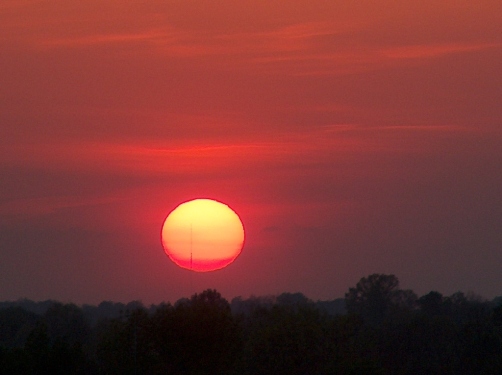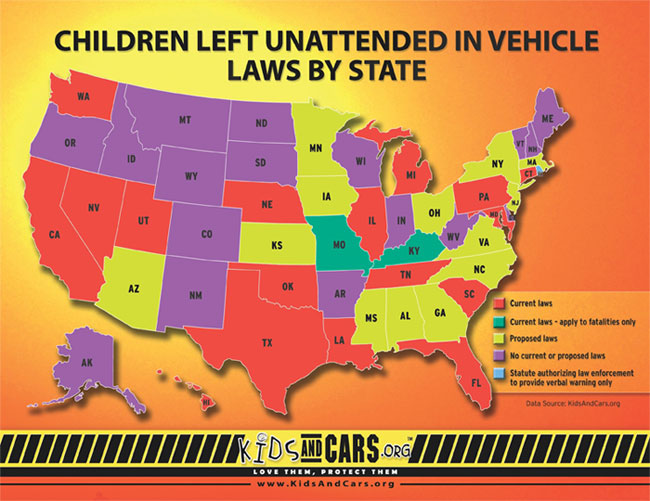
Well above average temperatures are forecast today into Wednesday over most of the lower 48 states away from the Gulf Coast. A storm system passing across southern Canada will bring a wintry mix to the upper Great Lakes today. A trailing cold front will then bring the wintry mix from the central Appalachians through the Northeast U.S. Wednesday and Thursday. Read More >
 Heat is the number one weather-related killer in the United States.The National Weather Service statistical data shows that heat causes more fatalities per year than floods, lightning, tornadoes and hurricanes combined. Based on the 10-year average from 2004 to 2013, excessive heat claims an average of 123 lives a year. In 2013, there were 92 heat related deaths. By contrast the 10-year average for hurricanes is 108; floods 75; tornadoes109; and lightning 33.
Heat is the number one weather-related killer in the United States.The National Weather Service statistical data shows that heat causes more fatalities per year than floods, lightning, tornadoes and hurricanes combined. Based on the 10-year average from 2004 to 2013, excessive heat claims an average of 123 lives a year. In 2013, there were 92 heat related deaths. By contrast the 10-year average for hurricanes is 108; floods 75; tornadoes109; and lightning 33.
In 1980 the nation saw a devastating heat wave and drought that claimed at least 1700 lives and had estimated economic costs $15 - $19 billion in 1980 dollars. In the heat wave of 1995 more than 700 deaths in the Chicago area were attributed to heat. In August 2003, a record heat wave in Europe claimed an estimated 50,000 lives.
North American summers are hot; most summers see heat waves in or more parts of the United States. East of the Rockies, they tend to combine both high temperature and high humidity, although some of the worst heat waves have been catastrophically dry. Additional detail on how heat impacts the human body is provided under "The Hazards of Excessive Heat" heading.
Each National Weather Service (NWS) Weather Forecast Office (WFO) can issue the following heat-related products as conditions warrant:
Excessive Heat Outlook: are issued when the potential exists for an excessive heat event in the next 3-7 days. An Outlook provides information to those who need considerable lead time to prepare for the event, such as public utilities, emergency management and public health officials. See the mean heat index and probability forecasts maps.
Excessive Heat Watch: is issued when conditions are favorable for an excessive heat event in the next 12 to 48 hours. A Watch is used when the risk of a heat wave has increased, but its occurrence and timing is still uncertain. A Watch provides enough lead time so those who need to prepare can do so, such as cities who have excessive heat event mitigation plans.
Excessive Heat Warning/Advisory are issued when an excessive heat event is expected in the next 36 hours. These products are issued when an excessive heat event is occurring, is imminent, or has a very high probability of occuring. The warning is used for conditions posing a threat to life or property. An advisory is for less serious conditions that cause significant discomfort or inconvenience and, if caution is not taken, could lead to a threat to life and/or property.
NOAA's heat alert procedures are based mainly on Heat Index Values. The Heat Index, sometimes referred to as the apparent temperature and given in degrees Fahrenheit, is a measure of how hot it really feels when relative humidity is factored with the actual air temperature.
To find the heat index, look at the Heat Index Chart. As an example, if the air temperature is 96°F (found on the top of the table) and the relative humidity is 65% (found on the left of the table), the heat index--how hot it feels--is 121°F. The National Weather Service will initiate alert procedures when the Heat Index is expected to exceed 105°- 110°F (depending on local climate) for at least 2 consecutive days.
IMPORTANT: Since heat index values were devised for shady, light wind conditions, exposure to full sunshine can increase heat index values by up to 15°f. also, strong winds, particularly with very hot, dry air, can be extremely hazardous.
The Heat Index Chart shaded zone above 105°F shows a level that may cause increasingly severe heat disorders with continued exposure and/or physical activity.
The a heat index calculator, follow this page: https://www.hpc.ncep.noaa.gov/html/heatindex.shtml
During extremely hot and humid weather the body's ability to cool itself is affected. When the body heats too rapidly to cool itself properly, or when too much fluid or salt is lost through dehydration or sweating, body temperature rises and heat-related illnesses may develop.
Heat-related illnesses can range from heat cramps to heat exhaustion to more serious heat stroke. Heat stroke can result in death and requires immediate medical attention.
Factors or conditions that can make some people more susceptible to heat-related illnesses include age (older adults and young children), obesity, fever, heart disease, mental illness, poor circulation, prescription drug and alcohol use, and sunburn. Sunburn, caused by ultraviolet radiation from the sun, can significantly retard the skin's ability to shed excess heat.
HEAT CRAMPS
HEAT EXHAUSTION
HEAT STROKE (or sunstroke)
Never Leave Children, Disable Adults or Pets in Parked Vehicles
Each year children die from hyperthermia as a result of being left in parked vehicles. Hyperthermia is an acute condition that occurs when the body absorbs more heat than it can dissipate. Hyperthermia can occur even on a mild day. Studies have shown that the temperature inside a parked vehicle can rapidly rise to a dangerous level for children, adults and pets. Leaving the windows slightly open does not significantly decrease the heating rate. The effects can be more severe on children because their bodies warm at a faster rate than adults.
Shown below is a time lapse photo of a thermometer reading in a car over a period of less than an hour. As the photograph shows, in just over 2 minutes the call went from a safe temperature to 94.3 degree F. These photos demonstrate just how quickly a vehicle can become a death trap for a child.

Hyperthermia deaths aren't confined to summer months. They also happen during the spring and fall. Below are some examples.
Adults are in danger too. On July 12, 2001, a man died of heatstroke after falling asleep in his car with the windows rolled up in the parking lot of a supermarket in Hinds County, MS.
The atmosphere and the windows of a car are relatively “transparent” to the sun’s shortwave radiation (yellow in figure below) and are warmed little. This shortwave energy, however, does heat objects it strikes. For example, a dark dashboard or seat can easily reach temperatures in the range of 180 to more than 200 degrees F.
These objects (e.g., dashboard, steering wheel, childseat) heat the adjacent air by conduction and convection and also give off longwave radiation (red) which is very efficient at warming the air trapped inside a vehicle.
Shown below is a time lapse photo of a thermometer reading in a car over a period of less than an hour. As the photograph shows, in just over 2 minutes the call went from a safe temperature to 94.3 degree F. These photos demonstrate just how quickly a vehicle can become a death trap for a child.

CLICK HERE FOR ANIMATION (700K)
( Hi-Res ~ 2.5 mb.WMV file)
Individual Frames:
0 min, 10 min, 20 min, 30 min, 40 min, 50 min, 60 min
(Animation Courtesy of General Motors and Golden Gate Weather Services)
Only 19 states have laws specifically addressing a child left unattend in a behind in a vehicle

In 2012 there were 32 child vehicular fatalities. So far in 2013 there was one fatality in Florida in May.
Child Safety Tips
Adult Heat Wave Safety Tips
 coolest time of the day. Children, senior and anyone with health problems should stay in the coolest available place, not necessarily indoors.
coolest time of the day. Children, senior and anyone with health problems should stay in the coolest available place, not necessarily indoors.SUNBURN: Redness and pain. In severe cases swelling of skin, blisters, fever, headaches. First Aid: Ointments for mild cases if blisters appear and do not break. If  breaking occurs, apply dry sterile dressing. Serious, extensive cases should be seen by physician.
breaking occurs, apply dry sterile dressing. Serious, extensive cases should be seen by physician.
HEAT CRAMPS: Painful spasms usually in the muscles of legs and abdomen. Heavy sweating. First Aid: Firm pressure on cramping muscles or gentle massage to relieve spasm. Give sips of water. If nausea occurs, discontinue water.
HEAT EXHAUSTION: Heavy sweating, weakness, skin cold, pale and clammy. Pulse thready. Normal temperature possible. Fainting and vomiting. First Aid: Get victim out of sun. Once inside, the person should lay down and loosen clothing. Apply cool, wet cloths. Fan or move victim to air conditioned room. Offer sips of water. If nausea occurs, discontinue water. If vomiting continues, seek immediate medical attention.
HEAT STROKE (or sunstroke): High body temperature (106° F or higher). Hot dry skin. Rapid and strong pulse. Possible unconsciousness. First Aid: HEAT STROKE IS A SEVERE MEDICAL EMERGENCY. SUMMON EMERGENCY MEDICAL ASSISTANCE OR GET THE VICTIM TO A HOSPITAL IMMEDIATELY. DELAY CAN BE FATAL. White waiting for emergency assistance, move the victim to a cooler environment Reduce body temperature with cold bath or sponging. Use extreme caution. Remove clothing, use fans and air conditioners. If temperature rises again, repeat process. Do not give fluids. Persons on salt restrictive diets should consult a physician before increasing their salt intake.
For more information contact your local American Red Cross Chapter. Ask to enroll in a first aid course.
The Excessive Heat Events Guidebook was developed by the Environmental Protection Agency (EPA) in 2006, in collaboration with the National Weather Service, the Centers for Disease Control and Prevention. This guidebook provides best practices for saving lives during heat waves in urban areas, and provides a menu of options that communities can use in developing their own mitigation plans.
This page was produced as a cooperative effort of the National Weather Service, the Federal Emergency Management Agency and the American Red Cross.
 |
 |
 |
 |
 |